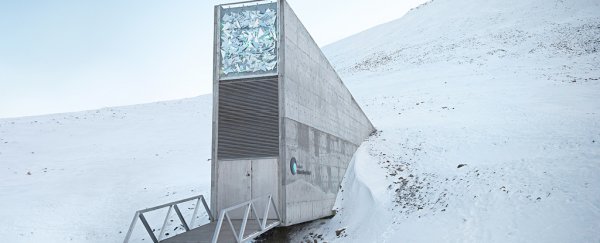The Global Seed Vault – an insurance policy against potential global doomsday scenarios – celebrated its 10th anniversary on Monday by receiving a shipment of more than 76,000 seed samples.
This brings the vault's library to a total number of 1,059,646 botanical specimens since it opened in 2008.
Set inside a mountain on the island Svalbard halfway between Norway and the North Pole, the vault is remote, cold, and reasonably dry. The perfect place to store plants in case we need to kick-start civilisation again.
The vault opens just twice a year to accept shipments of seeds donated by more than 70 institutions all over the globe.
With Monday's shipment we'll have ongoing access to plants such as black-eyed peas, unique varieties of rice, drought tolerant Bambara groundnut, and a variety of barley commonly used in Irish beer.
Because, seriously, is it even worth returning to civilisation if we can no longer brew Guinness?
"Hitting the million mark is really significant," senior scientist from the conservation group Crop Trust Hannes Dempewolf told Helen Briggs at BBC.
"Only a few years back I don't think we would have thought that we would get there."
The Norwegian government recently proposed a start-up of 100 million Norwegian Krone (around US$12.7 million) to help fund improvements to the vault in order to extend its viability.
And it's going to need every krone. Last year melting permafrost leaked water into the vault's entrance. While the vault's storage banks were at no point under threat, the event was a wake-up call to double down on its security against climate change.
New waterproofing measures have already been installed, but funding could help construct emergency power facilities and a new access tunnel.
The Svalbard vault is arguably the most famous facility of its kind, but it isn't the only one. A bank called the Arctic World Archive was opened just last year near the Global Seed Vault, tasked with storing records rather than seeds.
There are around 1,700 gene banks scattered all over the globe, safeguarding specimens of all varieties just in case war, natural disaster, or zombies happen to wipe out agriculture for a while.
While its post-apocalyptic benefits make great headlines, Svalbard's seed vault has already demonstrated its potential worth by returning 130 specimens to the International Centre for Agricultural Research in Dry Areas in Beirut, while its Aleppo office remains sealed off by the Syrian civil war.
So technically the bank currently has just 967,216 varieties on its shelves, with a number of grains of cultural and economic importance to Syria still out on loan.
Still, one million on the books is quite an achievement.
Scientists estimate there are a total of 2.2 million unique crop varieties held by all of the world's gene banks, meaning there's still some way to go before the Global Seed Vault has a complete set.
Thankfully it has the capacity to store another 3.5 million specimens, leaving plenty of milestones for future years.
Here's to another 10 years!
